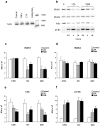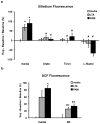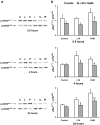Lipoteichoic acid from Staphylococcus aureus induces lung endothelial cell barrier dysfunction: role of reactive oxygen and nitrogen species
- PMID: 23166614
- PMCID: PMC3499573
- DOI: 10.1371/journal.pone.0049209
Lipoteichoic acid from Staphylococcus aureus induces lung endothelial cell barrier dysfunction: role of reactive oxygen and nitrogen species
Abstract
Tunneled central venous catheters (TCVCs) are used for dialysis access in 82% of new hemodialysis patients and are rapidly colonized with Gram-positive organism (e.g. Staphylococcus aureus) biofilm, a source of recurrent infections and chronic inflammation. Lipoteichoic acid (LTA), a cell wall ribitol polymer from Gram-positive organisms, mediates inflammation through the Toll-like receptor 2 (TLR2). The effect of LTA on lung endothelial permeability is not known. We tested the hypothesis that LTA from Staphylococcus aureus induces alterations in the permeability of pulmonary microvessel endothelial monolayers (PMEM) that result from activation of TLR2 and are mediated by reactive oxygen/nitrogen species (RONS). The permeability of PMEM was assessed by the clearance rate of Evans blue-labeled albumin, the activation of the TLR2 pathway was assessed by Western blot, and the generation of RONS was measured by the fluorescence of oxidized dihydroethidium and a dichlorofluorescein derivative. Treatment with LTA or the TLR2 agonist Pam((3))CSK((4)) induced significant increases in albumin permeability, IκBα phosphorylation, IRAK1 degradation, RONS generation, and endothelial nitric oxide synthase (eNOS) activation (as measured by the p-eNOS(ser1177):p-eNOS(thr495) ratio). The effects on permeability and RONS were effectively prevented by co-administration of the superoxide scavenger Tiron, the peroxynitrite scavenger Urate, or the eNOS inhibitor L-NAME and these effects as well as eNOS activation were reduced or prevented by pretreatment with an IRAK1/4 inhibitor. The results indicate that the activation of TLR2 and the generation of ROS/RNS mediates LTA-induced barrier dysfunction in PMEM.
Conflict of interest statement
Figures







References
-
- U.S. Renal Data System, USRDS Annual Data Report. (2009) Atlas of Chronic Kidney Disease and End-Stage Renal Disease in the United States, National Institutes of Health, National Institute of Diabetes and Digestive and Kidney Diseases, Bethesda, MD.
-
- Su CT, Hsueh PR, Wu VC, Wang CY, Hu FC, et al. (2010) Maintenance haemodialysis and delayed administration of appropriate antibiotics increase 30-day mortality among patients with non-hospital-acquired meticillin-resistant Staphylococcus aureus bacteraemia. Int J Antimicrob Agents. 35(5): 511–2. - PubMed
-
- Chen H, Bai C, Wang X (2010) The value of the lipopolysaccharide-induced acute lung injury model in respiratory medicine. Expert Rev Respir Med. 4(6): 773–83. - PubMed
-
- Hoogerwer JJ, de Vos AF, Bresser P, van der Zee JS, Pater JM, et al. (2008) Lung inflammation induced by lipotechoic acid or lipopolysaccharide in humans. Am. J Respir Crit Care Med 178: 34–41. - PubMed
Publication types
MeSH terms
Substances
Grants and funding
LinkOut - more resources
Full Text Sources
Medical
Miscellaneous

